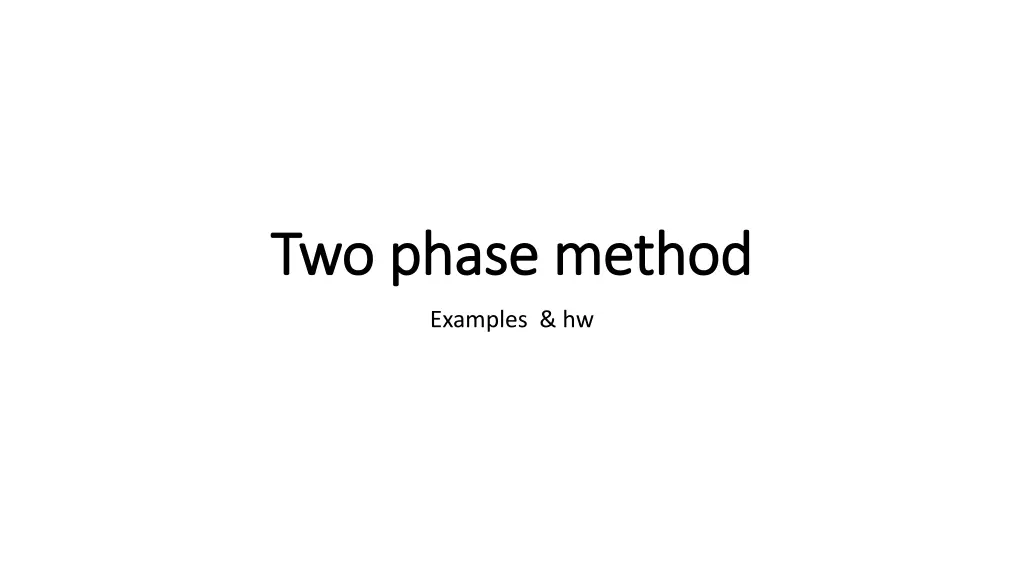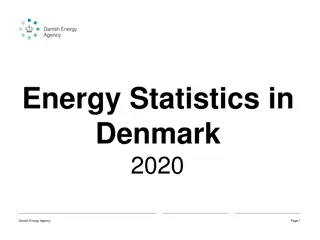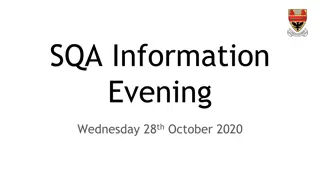
Two Phase Method in Linear Programming
Learn about the Two-Phase Method in linear programming, where artificial variables are eliminated in phase I to achieve an optimal solution in phase II. Follow step-by-step examples to understand how the method works and solves complex optimization problems effectively.
Download Presentation

Please find below an Image/Link to download the presentation.
The content on the website is provided AS IS for your information and personal use only. It may not be sold, licensed, or shared on other websites without obtaining consent from the author. If you encounter any issues during the download, it is possible that the publisher has removed the file from their server.
You are allowed to download the files provided on this website for personal or commercial use, subject to the condition that they are used lawfully. All files are the property of their respective owners.
The content on the website is provided AS IS for your information and personal use only. It may not be sold, licensed, or shared on other websites without obtaining consent from the author.
E N D
Presentation Transcript
Two phase method Two phase method Examples & hw
3-3 Two Phase Method The process of eliminating artificial variables is performed in phase- I of the solution and phase-II is used to get an optimal solution. Since the solution of LPP is computed in two phases, it is called as Two- Phase Simplex Method. Phase I in this phase, the simplex method is applied to a specially constructed auxiliary linear programming problem leading to a final simplex table containing a basic feasible solution to the original problem. Step 1- assign a cost-1 to each artificial variable and a cost 0 to all other variables in the objective function. Step 2- construct the auxiliary LPP in which the new objective function z* is to be maximized subject to the given set of constraints.
Step 3- solve the auxiliary problem by simplex method until either of the following three possibilities do arise. i. Max z* < 0 and at least one artificial vector appear in the optimum basic at a positive level ( j 0). In this case, given problem does not possess any feasible solution. ii. Max z* =0 and at least one artificial vector appears in the optimum basis at a zero level. In this case proceed to phase- II. iii. Max z* =0 and one artificial vector appears in the optimum basis. In this case also proceed to phase- II. Phase II- now assign the actual cost to the variables in the objective function and a zero cost to every artificial variable that appears in the basis at the zero level. This new objective function is now maximized by simplex method subject to the given constraints. Simplex method is applied to the modified simplex table obtained at the end of phase- I, until an optimum basic feasible solution has been attained. The artificial variables which are non- basic at the end of phase-I are removed.
Ex-1 Max z= 3x1-x2 S.T 2x1 + x2 2 X1+3x2 2 X2 4 X1 0, X2 0 Max Z =3X1-X2 Subject to 2x1+x2-S1+R1=2 X1+3X2+S2=2 X2+S3=4 X1,X2,S1,S2,S3,R1 0
Phase I Cj 0 0 0 0 0 -1 Basic var X1 X2 s1 s2 s3 R1 SOL R1 -1 2 1 -1 0 0 1 2 S2 0 1 3 0 1 0 0 2 S3 0 0 1 0 0 1 0 4 Z -2 -1 1 0 0 0 -2 x1 1 1/2 -1/2 0 0 x 1 S2 0 5/2 1/2 1 0 x 1 S3 0 1 0 0 1 x 4 Z 0 0 0 0 0 x 0 Since all ? 0, max z*=0 and no artificial vector appears in the basis, we proceed to phase II.
Phase II Cj 3 -1 0 0 0 Basic var X1 X2 s1 s2 s3 SOL X1 3 1 1/2 -1/2 0 0 1 S2 0 0 5/2 1/2 1 0 1 S3 0 0 1 0 0 1 4 Z 0 5/2 -3/2 0 0 3 X1 1 3 0 0 0 2 S1 0 5 1 2 0 2 S3 0 1 0 0 1 4 Z 0 10 0 3 0 6 Since all ? 0 , optimal basis feasible solution is obtained therefore the solution is: Max z=6, x1=2, x2=0
Ex MAx z=5x1+8x2 S.T 3x1+2x2 3 X1+4x2 4 X1+x2 5 and x1 0, x2 0 Solution Standard LPP Max Z=5X1+8X2 subject to 3X1+2X2-S1+R1=3 X1+4X2-S2+R2= 4 X1+X2+S3=5 X1,X2,S1,S2,S3,R1,R2 0
Auxiliary LPP Max Z*=0X1+0X2+0S1+0S2+0S3-1R1-1R2 subject to 3X1+2X2-S1+R1=3 X1+4X2-S2+R2=4 X1+X2+S3=5 X1,X2,S1,S2,S3,R1,R2 0 Phase I Cj 0 0 0 0 0 -1 -1 Basic var X1 X2 S1 S2 S3 R1 R2 SOL R1 -1 3 2 -1 0 0 1 0 3 R2 -1 1 4 0 -1 0 0 1 4 S3 0 1 1 0 0 1 0 0 5 Z -4 -6 1 1 0 0 0 -7 R1 5/2 0 -1 1/2 0 1 X 1 X2 1/4 1 0 -1/4 0 0 X 1 S3 3/4 0 0 1/4 1 0 X 4 Z -5/2 0 1 -1/2 0 0 X -1 X1 1 0 -2/5 1/5 0 X X 2/5 X2 0 1 1/10 -3/10 0 X X 9/10 S3 0 0 3/10 1/10 1 X X 37/10 Z*=0 0 0 0 0 0 0 X
Since all ? 0 , max z*=0 and no artificial vector appears in the basis, we proceed to phase II. Cj 5 8 0 0 0 Basic var X1 X2 s1 s2 s3 SOL x1 5 1 0 -2/5 1/5 0 2/5 X2 8 0 1 1/10 -3/10 0 9/10 S3 0 0 0 3/10 1/10 1 37/10 Z 0 0 -6/5 -7/5 0 46/5 S2 5 0 -2 1 0 2 x2 3/2 1 -1/2 0 0 3/2 s3 -1/2 0 1/2 0 1 7/2 Z 7 0 -4 0 0 12 S3 3 0 0 1 2 16 X2 1 1 0 0 1/2 5 S1 -1 0 1 0 2 7 Z 3 0 0 0 4 40 X1=0 X2=5 Z=40
Homework #Solve the LPP below by using two phase method Max Z = 3X1 + 2X2+ X3 S.T. 2X1 +X2+X3= 12 3X1+ 4X3=11 X1 0, X2 0 , X3 0






















